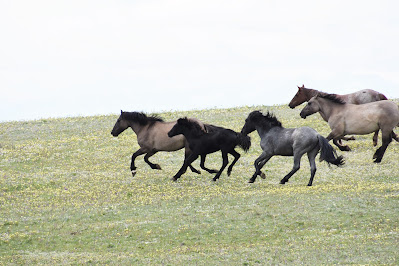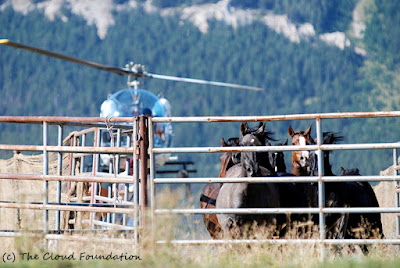Mustangs: An American Icon
There is something about the west that strikes everyone—the vast landscape, untamed plains, ancient Indian camps, and wild horses and burros. While all of these aspects have captivated the hearts of Americans for decades, mustangs are widely renowned for their beauty, strong family ties, and the freedom they greatly cherish. But when we dig deeper, a question may arise, “Why do we really have wild horses and burros?”
When Hernan Cortez came to the new world in 15191, he brought with him gorgeous Spanish horses. Their descendants are what we now know today as the American Mustang. Burros were later transported to America in the 1500’s2 on another Spanish boat. As the years went by, they began to be used by the Native Americans, and later by cowboys exploring the west. These hardy animals were prized for their strength and intelligence. It was then, as the west became settled, that the wild horses and burros became known as the western icon for beauty, freedom, and family. They have long since been cherished and protected by the American people.
Today, many claim that our wild horses and burros are still “protected”, according to the Wild Free-Roaming Horse and Burro Act of 19713, but in reality, they are not. As the Bureau of Land Management (BLM) continues to manage our wild horses and burros, the majority of wild horse herds have been eliminated due to the BLM’s poor management, welfare livestock ranching, and mining. The BLM is allowing livestock, such as cattle and sheep, to graze on government-designated lands for wild horses and burros, and subtly, they are removing the wild horses and burros for these purposes.
One of the first questions that many people ask is “Why can’t the livestock and mustangs just share the land?”. For over fifty years, the BLM and livestock ranchers have been working together to create a welfare ranching program, but they have been focusing on the needs of the cattle and sheep, not on our government-protected wild horses. Currently, these livestock receive 82% of the mustangs’ and burros’ forage; while the horses only get the remaining 18%.4 Livestock ranchers dislike the competition with the wild horses, and try to get rid of them.5 Then working together, the BLM manages the horses according to the ranchers’ needs. In consequence, there isn’t enough room for the mustangs, burros, and other wildlife to flourish. The livestock also ruin public lands: destroying water holes, grasses, and natural vegetation. The BLM should look to reduce grazing on our public lands or be more selective of who they give grazing allotments to. These are lands preserved for the American people’s enjoyment and are not just for the ranchers.
While the BLM claims that wild horses and burros are the ones responsible for destroying the lands, in reality, this is not the case. They are trying to hide the fact that it is the livestock, not the mustangs.6 The grazing patterns of sheep and cattle are very different and more destructive than horses’. Sheep travel together in herds7, eating much of the grass, then moving on to new grass, and on it goes. Thus, if not carefully managed, the ground gets trampled, making it hard for grass to grow back steadily. In comparison, horses graze by moving around to different areas constantly. Wild horses will travel many miles a day, grazing in different locations. Cattle do not have top teeth; therefore, they bite off the grass at the roots, sometimes tearing up the whole grass plant.8 They are ruminants and require a lot of water to digest their food. They don’t move far from a water source, and so they have a destructive effect on the landscape – denuding the soil and polluting the water.9 Horses’ grazing is beneficial to the ecosystem since they just eat the tops of the grass plant. Horses’ teeth are made to clip the grass, not rip up the whole plant. They cause less destruction to natural resources because they range a far larger area than cattle. As of August 2017, there are 37 cows for every one wild horse, yet the BLM and cattle ranchers continue to say that horses are the problem.10
A question often asked is “What is the problem with the BLM managing the horses and taking some out?”. Managing wildlife is dangerous and interferes with nature taking its course. Surprisingly, the BLM also keeps the population of cougars, bears, and wolves down. These are the wild horses’ and burros’ natural predators and keep the numbers in balance for the herds. Between 1926 and 1995 in Yellowstone National Park, there was a campaign to eliminate the gray wolf because of the extent of their population.11 They were nearly all wiped out. Consequently, the elk and deer population grew quickly. Aspen trees were decimated, cottonwoods and willows were demolished, and stream beds were ruined. The authorities saw that they were wrong in removing the wolves, and not only stopped killing them, but also added twenty more from Canada. Today, the deer, elk, rodents, and many other wildlife populations are kept in check because of the gray wolf. If the mustangs’ and burros’ predators would stop being killed, they too would help keep the horse population in check. If the livestock were taken off the wild horses’ and burros’ protected land, there would be more than enough for the horses. Currently, 177 wild horse and burro herds remain on 31.6 million acres, which surprisingly, is only 11% of BLM acreage.12
One false claim of the BLM is that the wild horse and burro helicopter roundups are not stressful to the horses, and that they do everything they can to ensure the wild horses and burros don’t get injured. However, many mustangs suffer severe injuries and even death, or are euthanized due to “pre-existing” conditions. Stallions attempt to reclaim their families and mares and foals are separated—this creates intense stress.
In the 2001 Pryor Mountains roundup, a wild horse band was gathered by helicopter and forced to run over thirty miles to where the trap was.13 Flint, the young colt in that band, suffered a life-threatening injury as a result of running so far over the rough ground. He and his family had to stay in a corral for several weeks while his hoof healed. Another example took place in 2017 when a roundup helicopter was pushing a mare, who appeared to be pregnant, to keep up with her band.14 A wrangler joined in the chase, and after missing several times, roped her. The mare then tried to jump over a fence. After getting tangled in the barbed wire, she made it to the other side. She escaped with the rope still attached to her and was not seen again. Helicopter roundups are inhumane and should be illegal. In addition to this, many of the mustangs and burros that are removed later end up in kill pens and get sold to slaughter, due to poor BLM oversight of its adoption program. (It is illegal for the BLM to sell horses directly to slaughter or to known kill buyers). However, many mustangs end up in the slaughter pipeline anyway. Whether their adopters weren’t prepared for the responsibility of a wild horse, or other circumstances, many are also sent to slaughter auctions due to being classified as “undesirable” by the BLM.15 Moreover, there is very limited room in the BLM’s already overstocked holding pens.
Another issue that is concealed from the public’s eye is the amount of tax dollars that go towards the BLM’s wild horse and burro program each year. Over 50,000 wild horses and burros are currently warehoused in holding facilities across the country at a cost of $120,000 per day to the American taxpayer.16 More mustangs live in holding than exist in the wild, at the expense of the American people. In addition, it costs taxpayers $123 million each year to support the BLM’s welfare grazing program for the livestock on public lands.17
For over 500 years, mustangs have roamed the American west. Despite the claims of the BLM, wild horses and burros are not truly protected. Livestock continue to invade our public lands, and roundups remove thousands of mustangs each year, consuming millions of tax dollars. Wild horses and burros should be allowed to live their entire lives in the precious freedom they love and live for. If our wild horses and burros become extinct, the American west will have lost its greatest symbol of freedom and family.










Comments
Post a Comment
Submit your comment here